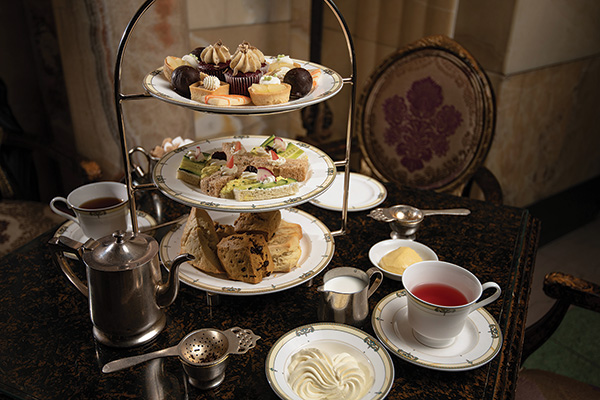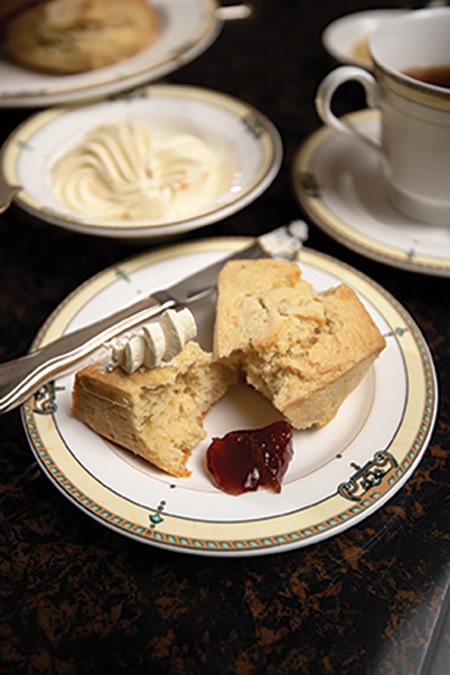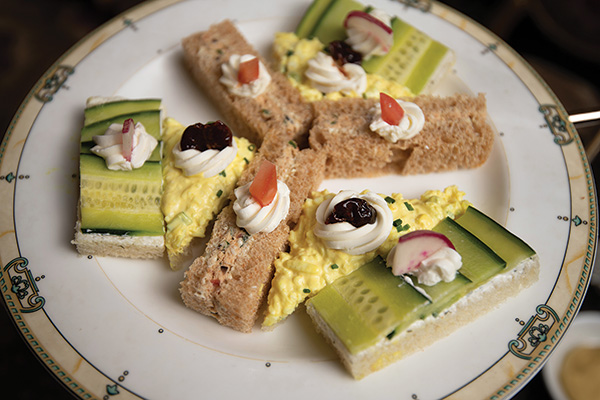Be a Part of History with HOLIDAY TEA at the Brown Palace

WHEN KIM MOYLE signed on as Executive Chef at The Brown Palace last year, she had no idea that she was the first female chef in the hotel’s 129-year history. Another surprise? Chef Moyle didn’t know about the year-round Brown Palace tea service before being hired. “A full-on tea? Are you kidding me? How is that even possible?” she recalls thinking. “As a chef, I’ve seen a lot of things, but to have a whole department is so much fun every day.”
She is as excited as every other Denverite to see the hotel’s grand atrium transformed into a holiday postcard. In early November, when the holiday chandelier, made from 250,000 glinting crystal beads, goes up in the eight-story lobby, the space becomes even more magical. Next up to kick off the season: bubbly poured at the annual 5,000-glass Champagne Cascade, 60,000 shimmering lights, 4,800 elegant ornaments and gilded velvet trimmings. Now, it’s the holidays.
Chef Moyle says this year there is a new tea company providing 20 teas and a new holiday blend just for The Brown Palace. They also matched the previous tea company’s popular Christmas tea blend, known for its soul-warming winter spices. Guests can enjoy the traditional selection of curry-egg salad and dill cream-cheese sandwiches, buttermilk and flavored scones with Devonshire cream and lemon curd, and of course cookies and seasonal pastries, wrapped like sweet-miniature gifts in fondant and chocolate.




The Brown Palace has offered tea service since the late 1800s, though not always in the atrium. “Initially, it was served in the Ladies Ordinary, a two-story room on the eighth floor of the hotel in one of the triangular building’s 45-degree-angle corners,” said Debra Faulkner, the hotel’s historian. In 1910, the ground floor lounge was dedicated to a daily 4:00 p.m. proper high tea for Denver’s ladies to socialize and show off a new frock or hat. A hotel publication from the period described it as a place where “a little extraordinary social debt might be repaid gracefully.”
Faulkner says that though the concept of tea lost popularity in the 1920s and ’30s during Prohibition, the rumors still stand that the wait staff took silver teapots into a tunnel beneath Tremont Place and filled them with a tea-colored bootleg for “special customers.” The atrium-lobby tea service began in 1986 and today’s menu includes champagne and champagne cocktails to sip while listening to live piano or harp music.
Chef Moyle feels privileged to be a part of something as meaningful as The Brown Palace. She loves seeing generations of families coming to tea dressed up and enjoying the hotel. “It’s an anomaly,” she says. “Other cities have a handful of people who feel that way about a historic property. In Denver, everyone feels like this hotel belongs to them.” She is right. Whether you are from a Colorado pioneer family or are a Colorado transplant, taking tea at The Brown (with or without a fancy hat and your pinky up) is a rite of passage sure to make you feel like a native Coloradan.
Reservations are highly recommended, brownpalace.com/dining/restaurants/afternoon-tea/


